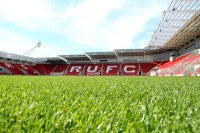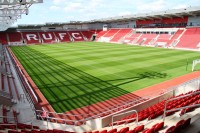New Home for Rotherham United
 Rotherham United Football Club has kicked off its 2012/2013 season in style after relocating to its latest home, the New York Stadium. The Millers moved to their new ground at the beginning of this season after spending over four years at Don Valley Stadium, one of the largest grounds in League Two. The move brings the team back in to the heart of Rotherham city centre and marks the completion of over three years of hard work.
Rotherham United Football Club has kicked off its 2012/2013 season in style after relocating to its latest home, the New York Stadium. The Millers moved to their new ground at the beginning of this season after spending over four years at Don Valley Stadium, one of the largest grounds in League Two. The move brings the team back in to the heart of Rotherham city centre and marks the completion of over three years of hard work.
Building the dream
GMI Construction was tasked with managing the entire project and sourcing the skilled suppliers for the more specialist jobs. The contract for the construction of the new pitch was put out to tender and won by Derbyshire-based sports field construction experts J Pugh Lewis.
"We were selected to work on the surface at the New York Stadium after Rotherham United and GMI visited Chesterfield Football Club's B2Net Stadium and were impressed by the pitch construction," explains Tim Pugh-Lewis, owner of J Pugh Lewis.
Work began on the new stadium, located on the former Guest and Chrimes Foundry site, in 2011. Due to the site being on a flood plain the ground surface had to be raised by two metres and consequently J Pugh Lewis started the construction of the pitch by levelling off its base to ensure they were working with a completely flat surface. Pipe drains were then installed lengthways at five metre intervals across the ground, which was then covered with 150mm depth of 2mm to 6mm gravel, 150mm of lower Rootzone sand and 150mm of Fibre Rootzone. The pitch was graded so that the centre spot was raised slightly to create a "shallow pyramid" to help with drainage. The surface was then seeded in multiple directions with a hard wearing perennial ryegrass.
"The project took approximately eight weeks to complete and was fairly straight forward in terms of the construction of the pitch itself. However, before any of the car parks were completed, the atrocious weather we experienced earlier this year caused the surrounding area of the ground to become very muddy - and trying to get 4,000 tonnes of sand and 1,500 tonnes of gravel in to the stadium through thick mud was a bit tricky!" continues Tim.
 Pugh-Lewis worked closely alongside Mansfield Sand, a developer and producer of sand-based products and natural turf pitch surfaces, on the construction of the pitch at Chesterfield's B2Net Stadium and this partnership proved to be just as successful at the New York Stadium.
Pugh-Lewis worked closely alongside Mansfield Sand, a developer and producer of sand-based products and natural turf pitch surfaces, on the construction of the pitch at Chesterfield's B2Net Stadium and this partnership proved to be just as successful at the New York Stadium.
Mark Robinson, Sports Surface Manager at Mansfield Sand, explains, "After visiting many different grounds and assessing their pitches, Rotherham United decided to install one of our Fibresand pitches.
"Fibresand is a unique polypropylene fibre reinforced silica sand that is incorporated into rootzones in order to provide extra stability to the surface. When integrated into a rootzone the fibres act as a mass of indestructible synthetic grass roots, reinforcing and stabilising the growing medium and producing a tighter, more divot resistant surface. Its resilience also means it is more groundsman friendly as it is easy to maintain," adds Mark.
Pitch Perfect
The person tasked with keeping the pitch at The New York stadium in pristine condition is Dave Fellowes.
A local lad, Dave began his career as an apprentice at the University of Sheffield, where he stayed for nine years after qualifying. From there he moved to Fulham Football Club working at their training ground. Within a year he was made the Club's Head Groundsman and at the age of 25 was the youngest head groundsman in the league.
"Working at both the University of Sheffield and Fulham gave me a great grounding in the industry," explains Dave. "Becoming head groundsman after only a year at Fulham was definitely one of the highlights of my career so far. The responsibility which came the with role definitely gave me more confidence. However, I wanted to come back home to Yorkshire so sent my C.V. speculatively to a few clubs in the region. I came for an interview at Rotherham and was offered the job.
"This has been the first time I have worked with a pitch from its construction to its seeding, and it has been a fantastic experience for me," continues Dave. "Knowing how the surface is built, right from the base layer through to the rootzone, has definitely given me an advantage when it comes to managing it. I was also able to participate in the decision making processes and offer advice when it came to choosing the right suppliers.
"I worked with Mansfield Sand in my previous role at Fulham, where the club has a Fibrelastic pitch, so I was aware of the benefits of the product and the service they provide - I was more than happy when Rotherham choose a Fibresand pitch."
The main aim throughout the summer was to establish the pitch surface and encourage strong root growth. This was achieved through drying and starving the grass before feeding it. Once the roots were established and the grass was strong Dave and his colleague, Dave Burton, maintained the surface with regular feeds every three and a half weeks and regular aeration. This routine will continue throughout the season
"There are just two full-time grounds staff at the club, so we are a small team. However, with the help of two cylinder motors and two rotary motors, we are more than able to keep the pitch looking and playing at its best. I believe this is down to the expertise and the knowledge of the team, but also because we are working with the highest quality raw materials.
"Many of the players have already said that this is the best pitch they have ever played on, which is testament to both the hard work of the grounds team and the Fibresand itself," concludes Dave.
For further information on Fibresand and other products from Mansfield Sand, please visit www.mansfield-sand.co.uk or call 01623 622441.
